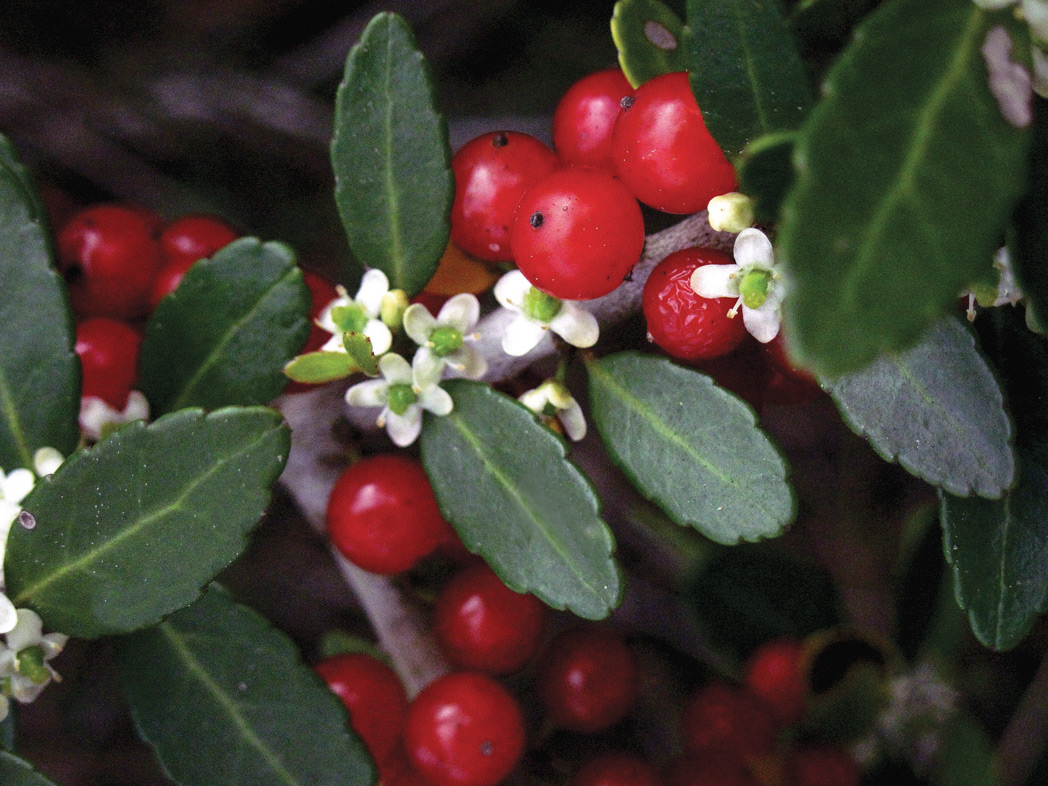Yaupon holly
Pictured above: Yaupon holly (Ilex vomitoria) by Eleanor Dietrich. Click on terms for botanical definitions. View post as a PDF.
Yaupon holly is an evergreen shrub or tree found in coastal and inland scrub, dunes, floodplains and hammocks. Its diminutive flowers bloom in spring, attracting a variety of bees and other insects. In the fall, abundant fruit production provides food for birds and small mammals. The dense evergreen foliage provides year-round cover for wildlife.
Yaupon holly’s flowers are small, white and born in clusters within leaf axils. Simple leaves are oval to elliptic, dark green and typically less than 1 inch long. They are leathery with crenate margins and alternate arrangement. Fruits are small (about ¼-inch in diameter) green berries that turn bright red when mature. Branches are slender. Bark is smooth and whitish-gray. The crown is densely branched.
Yaupon holly tea has been consumed for many centuries. Native Americans brewed a strong “black drink” (as it was known by early settlers) from its leaves. Confederate soldiers used the tea as a substitute for coffee. In recent years, Yaupon holly tea has seen a revival and is now available commercially. The plant is the only native North America species to contain caffeine. The leaves and stems may be used fresh, dried or roasted.
Family: Aquifoliaceae (Holly family)
Native range: Panhandle, peninsula south to Brevard, Highlands and Sarasota counties
To see where natural populations of Yaupon holly have been vouchered, visit florida.plantatlas.usf.edu.
Hardiness: Zones 8A–10A
Lifespan: Perennial
Soil: Moist to dry, well-drained soils
Exposure: Full sun to partial shade
Growth habit: 8–20’+ tall with crown spreading 5–10’+
Propagation: Cuttings, seed
Garden tips: Yaupon holly works well as a specimen plant or in a buffer or screen. It tolerates salt and wind and is adaptable to many soil types. Its form is irregular, but it can be pruned to a desired shape or height. It is prone to suckering, so periodic removal of unwanted sprouts may be necessary. The plant is dioecious, which means both a male and female specimen are needed to ensure pollination and fruit. Berries are produced only on female plants.
Caution: This popular plant has a long history of many cultivars that were created within and beyond Florida. Those with a more natural, open form—such as the weeping variety—allow for wildlife usage. Dwarf and tightly sheared forms, often from male plants, will not produce fruit or allow for shelter. Cultivars also restrict genetic diversity.
Yaupon holly plants are available from nurseries that specialize in Florida native plants. Visit www.PlantRealFlorida.org to find a nursery in your area.
For more information on other Ilex species, see:

